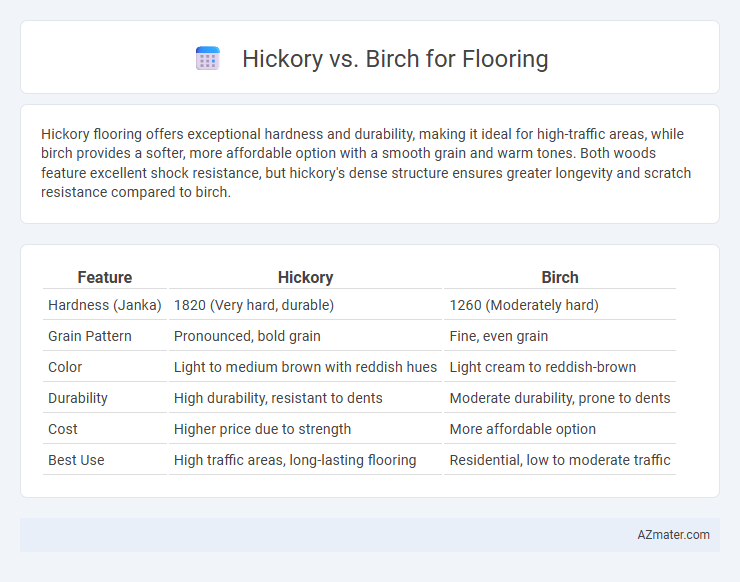Hickory flooring offers exceptional hardness and durability, making it ideal for high-traffic areas, while birch provides a softer, more affordable option with a smooth grain and warm tones. Both woods feature excellent shock resistance, but hickory's dense structure ensures greater longevity and scratch resistance compared to birch.
Table of Comparison
| Feature | Hickory | Birch |
|---|---|---|
| Hardness (Janka) | 1820 (Very hard, durable) | 1260 (Moderately hard) |
| Grain Pattern | Pronounced, bold grain | Fine, even grain |
| Color | Light to medium brown with reddish hues | Light cream to reddish-brown |
| Durability | High durability, resistant to dents | Moderate durability, prone to dents |
| Cost | Higher price due to strength | More affordable option |
| Best Use | High traffic areas, long-lasting flooring | Residential, low to moderate traffic |
Hickory vs Birch Flooring: An Overview
Hickory flooring offers superior hardness ratings of 1820 on the Janka scale, making it more durable than birch, which ranks around 1260. Hickory features pronounced grain patterns and rich color variations from light to dark brown, while birch flooring typically presents a subtler, uniform appearance with creamy to light reddish hues. Both hardwoods provide excellent stability and versatility for various interior designs, but hickory's toughness makes it a preferred choice for high-traffic areas.
Wood Hardness and Durability Comparison
Hickory flooring boasts a Janka hardness rating of approximately 1,820, making it one of the hardest and most durable domestic hardwoods available, ideal for high-traffic areas and heavy use. Birch flooring, with a Janka hardness around 1,260, offers moderate durability but is more susceptible to dents and scratches compared to Hickory. The higher density and toughness of Hickory contribute to superior resistance against wear, impact, and damage, ensuring longer-lasting flooring performance.
Visual Appearance and Grain Patterns
Hickory flooring features bold, pronounced grain patterns with dramatic color variations ranging from creamy white to rich brown, creating a rustic and dynamic visual appeal. Birch flooring offers a finer, more subtle grain with a smoother texture and consistent pale cream to light reddish-brown hues, imparting a warm and elegant look. The contrasting grain intensity and color depth make hickory ideal for statement floors, while birch suits spaces seeking a refined and uniform aesthetic.
Color Variations in Hickory and Birch
Hickory flooring offers a wide range of color variations, from creamy whites and light tans to rich browns and deep reddish hues, creating a dynamic, rustic appearance ideal for adding warmth and character to any space. Birch flooring typically features softer, more uniform color tones, ranging from pale yellow and light brown to subtle reddish undertones, which provide a smooth and consistent look suited for modern and traditional interiors alike. Both woods present distinct color palettes that influence the flooring's final aesthetic, with hickory favoring bold contrasts and birch leaning toward gentle, harmonious shades.
Installation Differences and Considerations
Hickory flooring, known for its hardness and density, often requires pre-drilling and more robust fasteners during installation to prevent splitting, whereas birch, being slightly softer, allows for easier nailing and cutting. Birch's uniform grain makes it more forgiving for precise cuts and fitting in complex layouts, while hickory's varied grain and hardness can challenge installers in achieving a smooth, even surface. Considering subfloor preparation, hickory demands a highly level base to avoid issues due to its stiffness, whereas birch tolerates minor subfloor imperfections better, impacting installation time and costs.
Maintenance and Long-Term Care
Hickory flooring requires more frequent maintenance due to its hardness and tendency to show scratches, but it resists dents better than birch, making it durable for high-traffic areas. Birch flooring, being softer, needs gentler cleaning methods and periodic refinishing to maintain its appearance over time. Both wood types benefit from regular sweeping, avoiding excessive moisture, and using manufacturer-recommended wood floor cleaners for long-term care.
Cost Comparison: Hickory vs Birch
Hickory flooring typically costs between $6 to $9 per square foot, while birch flooring ranges from $4 to $7 per square foot, making birch the more budget-friendly option. Installation costs for both hardwood types are similar, averaging $3 to $5 per square foot depending on region and complexity. Hickory's higher price reflects its exceptional hardness and durability, whereas birch offers a softer texture at a lower cost, influencing long-term maintenance expenses.
Environmental Impact and Sustainability
Hickory flooring is known for its durability but often comes from slower-growing trees, which can contribute to a longer replenishment cycle and potentially greater environmental impact if not sourced responsibly. Birch flooring tends to come from faster-growing trees, making it a more sustainable choice when harvested from well-managed forests certified by organizations like FSC. Both woods can be environmentally friendly options if obtained through sustainable forestry practices and local sourcing to reduce carbon footprint.
Best Use Cases for Each Wood Type
Hickory flooring excels in high-traffic areas and rustic interior designs due to its exceptional hardness and distinctive grain patterns, making it ideal for kitchens, hallways, and family rooms that require durability and character. Birch flooring, with its smooth texture and lighter tones, suits modern and contemporary spaces, including bedrooms and living rooms, where a softer, more uniform appearance is desired. Both woods perform well in residential settings, but hickory's resilience makes it preferable for heavy-use zones, while birch offers aesthetic versatility for low to medium-traffic environments.
Deciding Which Flooring Is Right for You
Hickory flooring offers exceptional hardness with a Janka rating of about 1,820, ideal for high-traffic areas requiring extreme durability, while birch, with a rating around 1,260, provides a softer yet still resilient option that is easier to work with and refinish. The natural grain pattern of hickory exhibits dramatic color variations and knots, creating a rustic look, whereas birch presents a more uniform texture with a lighter, consistent tone suitable for modern interiors. Cost-wise, hickory tends to be more expensive due to its durability and distinctive appearance, whereas birch offers a budget-friendly alternative that balances performance with aesthetic versatility.

Infographic: Hickory vs Birch for Flooring
 azmater.com
azmater.com